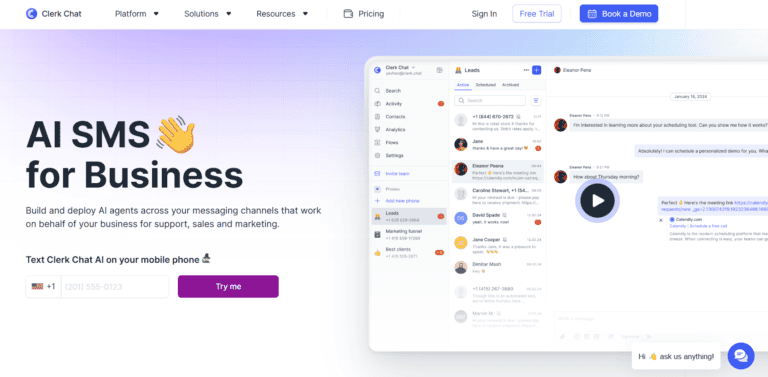How to Have Effective Meetings Even if You’re Short on Time
Are you drowning in a sea of unproductive meetings, watching precious hours slip away?
Picture this: You walk into a room (or log into a video call), and within minutes, decisions are made, action items are assigned, and everyone leaves feeling energized and accomplished.
Does it sound too good to be true? It’s not. Effective meetings aren’t just a pipe dream—they’re achievable, even when you’re racing against the clock.
The Harvard Business Review reports that executives spend an average of 23 hours weekly in meetings, yet 71% of senior managers say meetings are unproductive and inefficient. Imagine reclaiming those lost hours and transforming them into productivity powerhouses. With the right strategies, you can make every meeting count, boost team engagement, and drive your projects forward at lightning speed.
Ready to revolutionize your meeting game and become the go-to person for getting things done? Let’s dive in and discover how to have effective meetings that will leave your colleagues in awe and your to-do list conquerable.
What is an Effective Meeting?
An effective meeting is a purposeful gathering of relevant people that achieves its clear objective within the allotted meeting time, resulting in actionable outcomes and engaged meeting participants.
It’s a balanced blend of focused discussion, diverse perspectives, and decisive action planning that respects everyone’s time and contributions. In short, it’s a meeting that gets things done.
Why You Need to Know How to Run Effective Meetings
In today’s fast-paced business world, effective meetings are more crucial than ever. It’s not just about having good meetings but rather effective ones that maximize productivity, foster collaboration, and drive your organization forward.
Here’s why mastering effective meeting strategies is essential:
- Boosts productivity by eliminating time waste
- Enhances team engagement and morale
- Improves decision-making processes
- Facilitates better project planning and execution
- Promotes a culture of respect for time and resources
- Reduces meeting fatigue and increases focus on important tasks
By implementing our proven method for running effective meetings, you’ll reclaim valuable time and establish yourself as a results-oriented leader who knows how to get things done.
How to Have Effective Meetings
But we all know that not all meetings are effective. Some can be long, unproductive, and leave attendees feeling drained and unmotivated. So, how do you ensure that you are scheduling meetings that are always effective?
Transform your meetings from time sinks to productivity powerhouses with our PACE method: Prepare, Activate, Collaborate, and Execute. This unique process ensures that every meeting is purposeful, engaging, and results-driven.
Let’s break down each step to ensure you can implement this process in your next meeting, whether in person or on a remote video call.
#1) Prepare with Purpose
Before you even send out that meeting invitation, take a moment to really think about why this meeting is necessary. What are the specific goals you want to achieve? Having a clear purpose will not only guide your preparation but also help you stay focused during the meeting itself.
Once you’ve established your goals, it’s time to create a well-structured agenda. Think of this as your meeting roadmap—it’ll keep everyone on track and ensure that you cover all the essential topics.
Share this agenda with the participants beforehand so they can come prepared with their thoughts and ideas. Remember, a little prep work goes a long way toward making your meetings more efficient and productive.
Define the clear objective
What do you want to walk away with? A decision? A plan of action? A shared understanding of a complex issue? Whatever it is, put it into words. This clarity will serve as your guiding light throughout the meeting, ensuring that every discussion, every question, and every decision brings you closer to that desired outcome.
Once you’ve got your objective locked in, it’s time to create a focused agenda. This isn’t just a list of topics; it’s a strategic outline that allocates time to each discussion point. Be realistic about what you can cover in the allotted time frame, and prioritize the most critical items. This way, even if time gets tight, you’ll know you’ve addressed the essentials.
Invite only essential participants
Let’s be honest—we’ve all been in recurring meetings where we felt like our presence was optional. Maybe we weren’t involved in the topic, or our input wasn’t needed. These experiences aren’t just a waste of your time; they also drain the energy and focus of the entire group.
When you’re putting together your guest list, take a moment to consider who really needs to be there. Key decision-makers are a must – they’re the ones who can greenlight ideas or sign off on plans. But don’t forget those directly involved in the agenda items. They’ll bring valuable insights and perspectives that can lead to better outcomes.
Remember, a smaller, more focused group is often more productive than a larger, less engaged one. By inviting only essential participants, you’re not only respecting their time but also setting the stage for a more efficient and meaningful meeting.
Share pre-meeting materials
Think of it as setting the stage for an excellent performance. Just as you wouldn’t want to watch a movie without seeing the trailer, your meeting participants shouldn’t be left in the dark about what to expect. Sharing your agenda and relevant documents at least 24 hours in advance allows everyone to review the material, gather their thoughts, and come prepared to contribute.
This simple step can make a world of difference in the quality of your discussions. It allows people to familiarize themselves with the topics at hand, identify any questions or concerns, and brainstorm ideas beforehand. As a result, you’ll spend less time on explanations and more time on meaningful dialogue and decision-making.
So, before you hit “send” on those calendar invites, take a few minutes to compile and distribute all the necessary information. You’ll be glad you did when you see how much smoother and more productive your meeting becomes.
Set up the meeting space
Whether you’re meeting in person or virtually, the environment plays a surprisingly significant role in how well the meeting goes. A comfortable, well-equipped space can encourage participation and creativity, while a cramped, chaotic one can stifle discussion.
If you’re meeting in person, ensure the room is clean, well-lit, and has enough seating for everyone. Check whether the technology works – a projector, whiteboard, or video conferencing system. Little things like having water and snacks on hand can also go a long way in making people feel welcome and comfortable.
For virtual meetings, choose a reliable platform and test your audio and video beforehand. Make sure your background is professional and free of distractions. And if you’re sharing your screen, close any unnecessary tabs or applications to avoid confusion.
By setting up the meeting space for a few minutes, you’re sending a message that this meeting is important and that you value everyone’s time. Plus, a comfortable environment can help people relax and focus on the discussion at hand, leading to better outcomes.
#2) Activate Engagement
The first few minutes of your meeting are critical for setting the tone and getting everyone engaged. Here’s how to start strong:
Begin on time
Have you ever been stuck waiting for a meeting to start, watching the minutes tick by? It’s not just frustrating; it’s disrespectful to everyone’s time. When you start a meeting on time, you’re sending a clear message: you value the commitments of those present.
Punctuality sets a professional tone. It shows that you’re organized, prepared, and ready to tackle the agenda. This creates a positive atmosphere from the get-go, making it easier to get everyone on board and engaged in the discussion.
Don’t wait for stragglers. By starting promptly, you also encourage those who arrived on time to continue doing so in the future. It reinforces the idea that meetings are a valuable use of time, not just something to squeeze in between other tasks.
So, the next time you schedule a meeting, commit yourself and the participants to starting on time every time. You’ll be surprised at how much more productive and respectful your meetings become.
Set ground rules
Have you ever been in a meeting where someone’s phone keeps buzzing or side conversations derail the discussion? It’s not just distracting; it’s downright unproductive. That’s why setting ground rules is crucial for creating a focused and respectful environment.
Think of it as setting the tone for the meeting. By establishing clear expectations around participation and device usage, you’re letting everyone know that this space is where their contributions are valued and their attention is expected.
Some standard ground rules include:
- One speaker at a time: This ensures everyone can be heard and prevents the conversation from becoming chaotic.
- No phones or laptops unless absolutely necessary: This minimizes distractions and helps people stay present in the moment.
- Respectful disagreement: Encourage open dialogue and diverse perspectives but emphasize the importance of respectful communication.
Setting these ground rules upfront creates a level playing field where everyone feels comfortable participating and contributing to the discussion. Plus, it sends a message that you take the meeting seriously and expect others to do the same.
Review the meeting agenda
Take a few minutes to review the meeting objective and key points to be discussed quickly. This brief overview will remind everyone why they’ve gathered and set the stage for a focused conversation.
By recapping the agenda, you’re allowing everyone to get on the same page and ensure they’re prepared to contribute meaningfully. It also helps prevent any surprises or misunderstandings down the line. Think of it as a mental roadmap guiding everyone towards a common destination.
This quick review doesn’t need to be lengthy or detailed. Just a few sentences highlighting the main goal and the key topics you’ll cover is enough to get everyone oriented and ready to engage. Remember, a little preparation goes a long way in ensuring a productive and efficient meeting.
Assign roles
Every instrument contributes to creating a harmonious sound. Similarly, assigning roles in a meeting ensures that everyone contributes to its success. Two crucial roles are the timekeeper and note-taker.
The timekeeper is your guardian of the schedule. They closely monitor the clock, ensuring each agenda item gets its fair share of attention. This helps prevent any one topic from dominating the discussion and provides you with cover all the essential ground. It’s like having a gentle nudge to keep things moving along and ensure the meeting ends on time.
The note-taker is your memory bank. They capture the key points, decisions, and action items discussed during the meeting. This creates a valuable record that can be referred to later, ensuring that nothing falls through the cracks. It’s like having a written transcript of the conversation, allowing everyone to revisit the important takeaways.
By assigning these roles, you’re not just distributing responsibility but also empowering participants to actively contribute to the meeting’s success. This creates a sense of ownership and accountability, fostering a more engaged and productive atmosphere.
So, the next time you plan a meeting, consider assigning these roles and watch how they transform the dynamic of your discussions.
Use an icebreaker
A quick icebreaker at the start of a longer meeting can shake off the cobwebs, get creative juices flowing, and foster a sense of camaraderie among participants. It’s a fun and easy way to set a positive tone and encourage active participation right from the start.
#3) Collaborate Effectively
The heart of any effective meeting lies in meaningful collaboration. Here’s how to foster productive discussion and balanced participation:
Facilitate focused discussion
Gently redirect conversations that stray off course and tactfully steer discussions back to the relevant points. This ensures that everyone’s time is well-spent and the meeting stays on track to achieve its goals.
Encourage diverse perspectives
Imagine a meeting where everyone feels comfortable sharing their thoughts, no matter how unconventional. That kind of environment sparks innovation and leads to better solutions.
To achieve this, foster an open and inclusive atmosphere where all ideas are welcomed and respected. Actively seek out different viewpoints, encourage healthy debate, and celebrate the unique contributions of each participant. Remember, the best ideas often come from unexpected sources.
Manage time effectively
Remember that carefully crafted agenda? Now’s the time to put it to good use. Be mindful of the time allotted for each item and keep the conversation focused on the topic at hand.
If a discussion starts to veer off course, gently steer it back on track. This ensures that every item gets the attention it deserves and prevents the meeting from dragging on unnecessarily.
Park off-topic ideas
Great ideas can strike at any time, but that doesn’t mean they always belong in the current conversation. When those “aha” moments happen, jot them down in a designated “parking lot” for later discussion. This acknowledges the value of the idea without letting it hijack the meeting’s focus.
Use visual aids
They say a picture is worth a thousand words, and that holds true for meetings as well. Whiteboards or screen-sharing tools can bring your ideas to life, making them easier to grasp and more engaging. Diagrams, charts, or even simple bullet points can transform abstract concepts into tangible visuals, helping everyone stay on the same page.
Practice active listening
Imagine a successful meeting where everyone feels heard and understood. That’s the power of active listening. It’s about more than just hearing the words; it’s about tuning into the nuances of communication, both verbal and non-verbal.
In video meetings, pay attention to facial expressions, body language, and tone of voice. This will help you understand the full meaning behind what’s being said and foster a deeper connection with your colleagues.
Key Considerations For Successfully Running Effective Meetings
Remember that effective meetings are as much about culture as they are about process. Encourage a culture of punctuality and preparation among your team members. Lead by example by always being prepared and respecting others’ time.
To ensure full engagement, consider implementing a “no devices” policy during in-person meetings. For remote meetings, ask participants to turn on their cameras to promote better connection and allow for reading facial expressions.
Implement “meeting-free” days or time blocks to allow for focused work. This can significantly boost individual productivity and reduce meeting fatigue.
Lastly, be mindful of the frequency of your meetings. Research shows that too many meetings can be counterproductive. Conduct a meeting audit regularly: evaluate how many meetings you have and determine if they’re still necessary and productive.
Taking it to the Next Level: Implement Fireflies.ai
While the tips we’ve shared are undoubtedly valuable, there’s always room for improvement. That’s where Fireflies.ai comes in. This innovative AI meeting assistant can revolutionize how you approach meetings by automating tasks, enhancing collaboration, and providing valuable insights.
From transcription and note-taking to action item tracking and follow-up reminders, Fireflies.ai takes the burden off your shoulders so you can focus on what truly matters – achieving your meeting objectives.
Alternatives to Traditional Meetings
While mastering effective meetings is crucial, sometimes alternatives can be even more efficient. Here are some options to consider:
Stand-up meetings
These brief, daily check-ins are designed to keep everyone in the loop without eating up valuable time. They’re perfect for sharing quick updates, identifying any roadblocks, and aligning on priorities for the day.
Walking Meetings
Take your one-on-one discussions outdoors to combine productivity with physical activity. Walking meetings can spark creativity, improve focus, and provide a refreshing change of scenery.
Asynchronous updates
Leverage the power of technology to keep your team informed without needing real-time meetings. Tools like Slack, Notion, or Loom allow team members to share progress updates, ask questions, and collaborate on documents at their own pace.
Office hours
Instead of scheduling numerous meetings, designate specific times when you’re available for questions and discussions. This allows team members to drop in as needed, reducing the need for formal meetings and allowing for more spontaneous interactions.
Remember, the best approach will depend on your specific needs and the nature of the task at hand. Experiment with different alternatives to discover what works best for you and your team.
Final Thoughts on Effective Meetings
As a project manager with over a decade of experience, I’ve seen firsthand the transformative power of successful meetings. By implementing these strategies, I’ve helped team leaders and teams reclaim countless hours of productivity and dramatically improve their collaboration and decision-making processes.
Remember, the key to effective meetings is preparation, engagement, collaboration, and execution. You’ll find that even your shortest meetings can drive significant results with practice. Start applying these techniques today, and watch as your team’s productivity and satisfaction soar.
Your time is a precious resource – use it wisely. Here’s to more effective meetings and less time wasted. Now, go forth and conquer those meeting schedules!








